Santa Croce Without a Baedeker
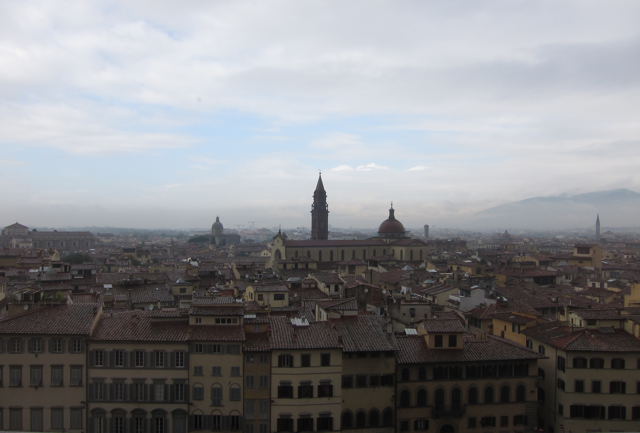
And so Day Three of our Florentine adventures dawned, pouring with rain. We decided to cross the street and visit the Pitti Palace, and dear readers, given the choice, I would definitely wait for a sunny day, skip the seemingly endless room after room of painting after painting and go instead to the Boboli Gardens, adjacent to the Palace. The only truly memorable thing about the Pitti Collection, for us that day, was the discovery of what I now think of as “The Number One Way I Don’t Want To Be Martyred.” Poor Saint Agatha.
But at least we did get the view, above, of the clearing sky around lunchtime, and we left our cultural advancement behind in order to feast on our market takings, back at home.
I have been trying to find, in my little Italian dictionary, what the word was that the baker was using when I bought this bread. It sounded like “sketchy,” but I cannot find it, really. It was like a very crusty, salty focaccio. Since we had lost the battle of No White Food already with the flour in the spinach dumplings TWO nights in a row, it seemed the better part of valor to eat this lovely bread, with our cheese and salami.
And then the skies cleared, and since the apartment was to open as the Barret-Browning Museum that afternoon, we decided to get ourselves to Santa Croce, a la “A Room With A View,” one of my favorite all-time books and films. And it was just lovely.
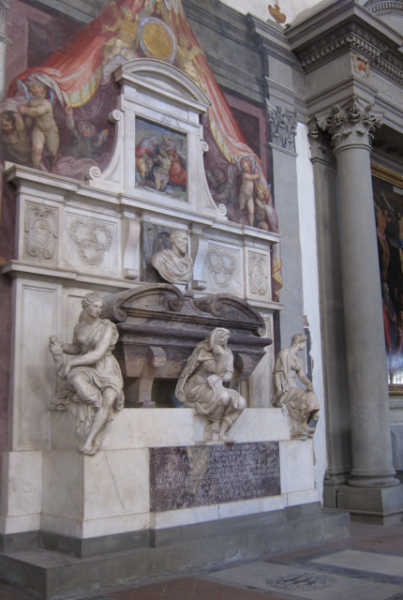 Dear Michelangelo’s tomb! Designed by Vasari, which I had forgotten. I really must encourage Avery to read his Lives of the Artists, one of the best, most gossipy takes on Florence in the Renaissance that you could wish for. He knew everyone, and believe me, what happened in Florence did NOT stay in Florence. He told all.
Dear Michelangelo’s tomb! Designed by Vasari, which I had forgotten. I really must encourage Avery to read his Lives of the Artists, one of the best, most gossipy takes on Florence in the Renaissance that you could wish for. He knew everyone, and believe me, what happened in Florence did NOT stay in Florence. He told all.
We wandered around in the patchy sunlight, looking at all the plaques and tombs to various people of note: Marconi, who invented the radio, and Machiavelli, there are a couple of strange bedfellows! And Lorenzo Ghiberti, he of the golden doors on the Baptistery, and Dante! Sadly the Giotto frescoes were in restauro, which is one of the hazards of visiting Florence. When I lived there for a summer, 25 years ago, it seemed we were constantly walking all the way across the city to see some chapel or other, only to find it chiuso when we got there. Avery pointed out that, “Fair enough, it’s been 25 years, they probably NEED restoring.” I could use a little touching up myself.
From Santa Croce, we escaped into bright sunshine and mutually decided that for the moment, we were both art-ed out and church-ed out. Avery was aiming for some gelato, and I had some serious food shopping to do.
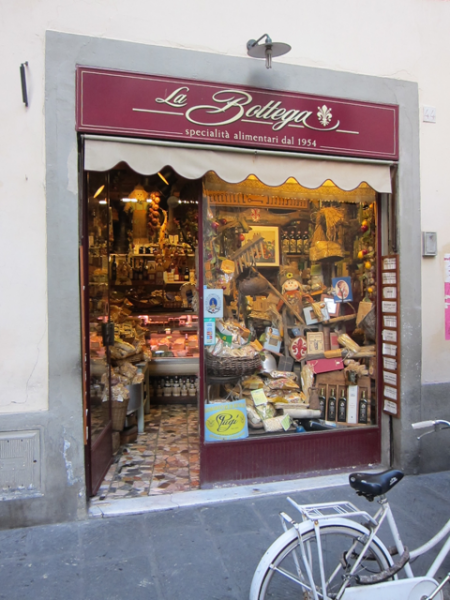 This shop, in a tiny, winding side street, the Via Dei Neri off the piazza Santa Croce, had everything! Balls of homemade mozzarella di bufala, creamy and almost falling apart, olives of every description, the most expensive tuna in olive oil I have ever come across — 12 euros for a jar! — and an enormous, towering rack of spices in glass tubes corked like wine bottles. And a gorgeous prosciutto, not too salty. And jars of fagioli, the white beans so much more delicious, simply sauteed with olive oil and garlic, than any bean living in England. Why? Because everything in Italy tastes better than anything anywhere else. It’s in the air.
This shop, in a tiny, winding side street, the Via Dei Neri off the piazza Santa Croce, had everything! Balls of homemade mozzarella di bufala, creamy and almost falling apart, olives of every description, the most expensive tuna in olive oil I have ever come across — 12 euros for a jar! — and an enormous, towering rack of spices in glass tubes corked like wine bottles. And a gorgeous prosciutto, not too salty. And jars of fagioli, the white beans so much more delicious, simply sauteed with olive oil and garlic, than any bean living in England. Why? Because everything in Italy tastes better than anything anywhere else. It’s in the air.
We came home laden with parcels — fresh artichokes and firm heads of finocchio, fennel, with which I proposed to make a salad. And when I cut into the first artichoke, look what I found… or rather, “who.”
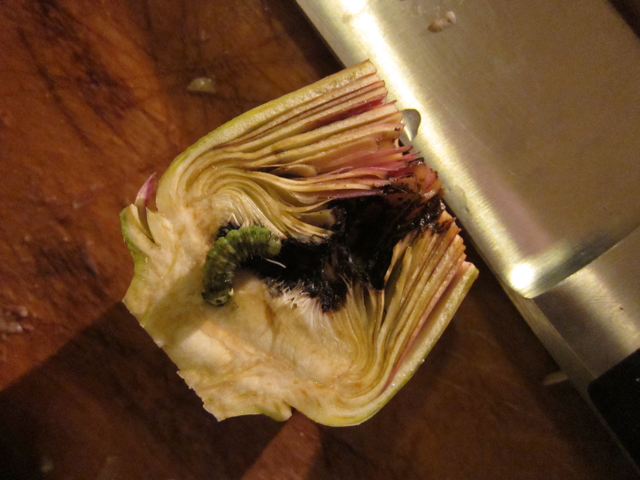 What a lucky fellow, that I didn’t cut him in half! I shrieked! Everyone came running. “You must put him outside somewhere, Mummy!” Avery wailed, so I went to show him to Elena, the lovely housekeeper who was acting as docent in the museum that afternoon. “Where shall I put him?” “There is a potted lemon tree outside your bathroom. He can go there. And don’t worry: you can still eat the artichoke!” she assured me, 100% Italian. Well trimmed and washed, it made a lovely salad, and the caterpillar earned his siesta in the lemon tree.
What a lucky fellow, that I didn’t cut him in half! I shrieked! Everyone came running. “You must put him outside somewhere, Mummy!” Avery wailed, so I went to show him to Elena, the lovely housekeeper who was acting as docent in the museum that afternoon. “Where shall I put him?” “There is a potted lemon tree outside your bathroom. He can go there. And don’t worry: you can still eat the artichoke!” she assured me, 100% Italian. Well trimmed and washed, it made a lovely salad, and the caterpillar earned his siesta in the lemon tree.
Meanwhile, the wild boar stew bubbled away. Following the restaurateur’s instructions of the night before, the chunks of gorgeously marbled meat had reposed, overnight, in a bath of red wine. Now, it filled the apartment with its garlicky aroma.
Stufato di Cinghiale
(serve 4)
1 kilo/2 lbs wild boar meat, cut into manageable chunks
1 bottle adequate red wine
leftover tops and leaves of 2 bulbs fennel
1 white onion, quartered
6 cloves garlic, crushed slightly
olive oil to cover bottom of cooking dish
1 lb chestnut or white mushrooms, quartered
2 cups beef or chicken stock
1/2 cup panna al tartufo, truffled cream, if you’re in Florence: ordinary cream if not
dash truffle oil
Wash the meat and dry it with paper towels. Place in a heavy-bottomed dish large enough to contain all the ingredients. Pour over the wine, then throw in the fennel tops, onions and garlic. Leave in fridge overnight, covered.
Six hours before you are ready to eat, drain away all but about 1/2 cup of the wine, leaving the vegetables in the dish with the meat, then add the mushrooms and the stock, to cover the meat.
Cook at a very low temperature, perhaps 200F/100C, so that the meat bubbles slightly, either on the stovetop or in the oven, for six hours. Check to make sure the stew is bubbling constantly, and stir occasionally.
When the meat is thoroughly cooked and tender, add the truffle or regular cream and the drizzle of truffle oil. Serve with noodles or bread.
**************************
While this stew was very good, I do not think it bubbled quite consistently enough in the oven while we were away, because I was so intent on having the oven low. As a result, the meat was a bit tougher than I would like, not the melting quality of my shoulder of beef cooked much the same way. It’s also possible that wild boar is simply tougher. I have one rather famous cooking friend who says he’s never cooked it to his complete satisfaction. But he keeps trying, because the flavor is so lovely. Not a big gamey, but a big, meaty flavor that went perfectly with the mushrooms and cream
And to start, we had a truly Italian appetizer: mozzarella di bufala with shaved truffles, and a drizzle of truffle oil. So simple, so perfect.
 Sighs of delight all around, in the tall-ceilinged dining room, where we felt like visiting royalty. Out for gelato in the Piazza de la Signora, with all the other tourists, which can be fun if you just forget how much you’d like to fit in, and live there… and home to fall exhausted to sleep, with the motorbikes screeching outside the windows, the sounds of far-off music, voices shouting in Italian too fast to be understood. Heaven, in short.
Sighs of delight all around, in the tall-ceilinged dining room, where we felt like visiting royalty. Out for gelato in the Piazza de la Signora, with all the other tourists, which can be fun if you just forget how much you’d like to fit in, and live there… and home to fall exhausted to sleep, with the motorbikes screeching outside the windows, the sounds of far-off music, voices shouting in Italian too fast to be understood. Heaven, in short.


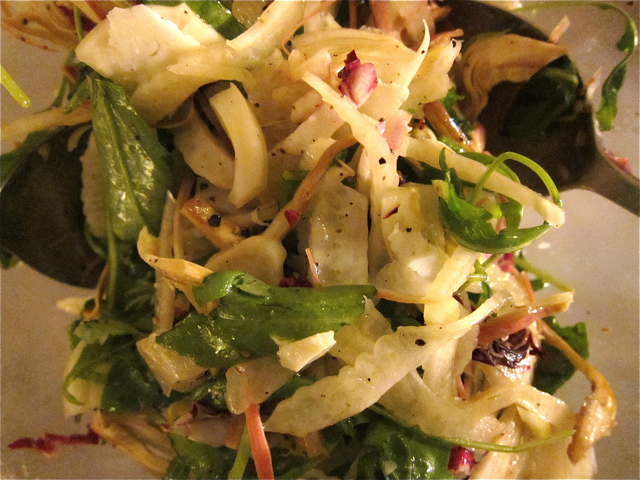
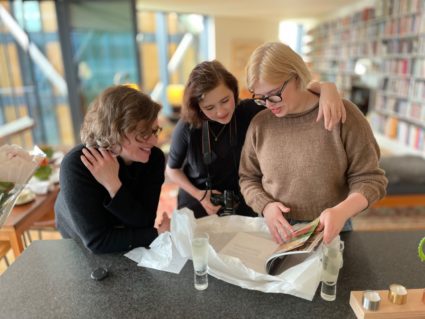
I love “Room with a View”–book and move, and I am enjoying your tour of Florence. We were there for a day trip earlier this year and I was so overwhelmed by the tourists, it really put me off. I wanted it to be the Florence of Lucy and Cecil’s time.
That is one lucky caterpillar, by the by. I found a worm in my organic box cabbage once. It made me shriek too… and I cancelled my standing box order. I’m not very garden friendly, I’m afraid.
JaPRA, maybe October halfterm is the time to go. There were tourists, but not to annoy. I felt Lucy in Santa Croce, for sure.
Love the worm story! Our gardening instincts last, we’ve discovered, precisely 14 minutes, but we can do it for three more minutes, then we’re done.